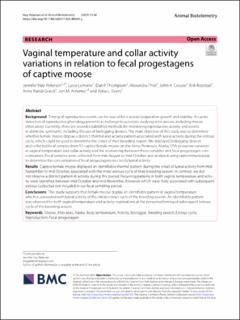| dc.contributor.author | Høy-Petersen, Jennifer | |
| dc.contributor.author | Lemiere, Lucie | |
| dc.contributor.author | Thompson, Dan P. | |
| dc.contributor.author | Thiel, Alexandra | |
| dc.contributor.author | Crouse, John A. | |
| dc.contributor.author | Ropstad, Erik | |
| dc.contributor.author | Græsli, Anne Randi | |
| dc.contributor.author | Arnemo, Jon Martin | |
| dc.contributor.author | Evans, Alina | |
| dc.coverage.spatial | USA, Alaska | en_US |
| dc.date.accessioned | 2024-03-08T13:30:13Z | |
| dc.date.available | 2024-03-08T13:30:13Z | |
| dc.date.created | 2023-10-29T16:45:50Z | |
| dc.date.issued | 2023 | |
| dc.identifier.citation | Animal Biotelemetry. 2023, 11 (1), . | en_US |
| dc.identifier.issn | 2050-3385 | |
| dc.identifier.uri | https://hdl.handle.net/11250/3121627 | |
| dc.description.abstract | Background
Timing of reproductive events can be crucial for a species’ population growth and stability. Accurate detection of reproductive phenology presents a challenge to scientists studying wild species, including moose (Alces alces). Currently, there are several established methods for monitoring reproductive activity and events in domestic ruminants, including the use of biologging devices. The main objective of this study was to determine whether female moose display a distinct thermal and activity pattern associated with luteal activity during the estrous cycle, which could be used to determine the onset of their breeding season. We deployed biologging devices and collected fecal samples from 12 captive female moose on the Kenai Peninsula, Alaska, USA to explore variation in vaginal temperature and collar activity and the relationship between these variables and fecal progestagen concentrations. Fecal samples were collected from mid-August to mid-October and analyzed using radioimmunoassay to determine the concentration of fecal progestagens to classify luteal activity.
Results
Captive female moose displayed an identifiable thermal pattern during the onset of luteal activity from mid-September to mid-October, associated with the initial estrous cycle of their breeding season. In contrast, we did not observe a distinct pattern in activity during this period. Recurring patterns in both vaginal temperature and activity were identified between mid-October and mid-November, however, which were likely associated with subsequent estrous cycles but not included in our fecal sampling period.
Conclusions
This study supports that female moose display an identifiable pattern in vaginal temperature which is associated with luteal activity of the initial estrous cycle of the breeding season. An identifiable pattern was observed for both vaginal temperature and activity registrations at the presumed timing of subsequent estrous cycle of the breeding season. | en_US |
| dc.language.iso | eng | en_US |
| dc.rights | Navngivelse 4.0 Internasjonal | * |
| dc.rights.uri | http://creativecommons.org/licenses/by/4.0/deed.no | * |
| dc.subject | moose | en_US |
| dc.subject | Alces alces | en_US |
| dc.subject | Alaska | en_US |
| dc.subject | body temperature | en_US |
| dc.subject | activity | en_US |
| dc.subject | biologger | en_US |
| dc.subject | breeding season | en_US |
| dc.subject | estrous cycle | en_US |
| dc.subject | reproduction | en_US |
| dc.subject | fecal progestagen | en_US |
| dc.title | Vaginal temperature and collar activity variations in relation to fecal progestagens of captive moose | en_US |
| dc.title.alternative | Vaginal temperature and collar activity variations in relation to fecal progestagens of captive moose | en_US |
| dc.type | Peer reviewed | en_US |
| dc.type | Journal article | en_US |
| dc.description.version | publishedVersion | en_US |
| dc.rights.holder | © The Author(s) 2023. | en_US |
| dc.subject.nsi | VDP::Matematikk og Naturvitenskap: 400::Zoologiske og botaniske fag: 480 | en_US |
| dc.source.pagenumber | 13 | en_US |
| dc.source.volume | 11 | en_US |
| dc.source.journal | Animal Biotelemetry | en_US |
| dc.source.issue | 1 | en_US |
| dc.identifier.doi | 10.1186/s40317-023-00345-y | |
| dc.identifier.cristin | 2189666 | |
| cristin.ispublished | true | |
| cristin.fulltext | original | |
| cristin.qualitycode | 1 | |

